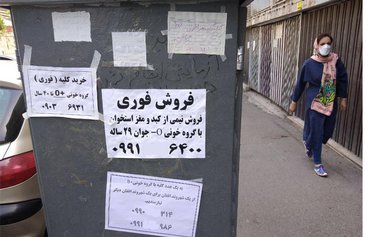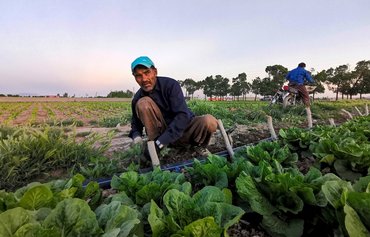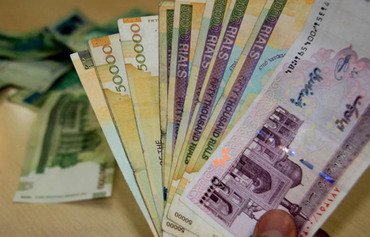All the main economic indicators in Iran show that the Islamic Republic is in a grave situation, with inflation skyrocketing, currency reserves plummeting, and growing discontent with the country's leadership.
The fear of dissent, fueled by the massive economic pressure the population is facing, is such that the Interior Ministry has formed a committee to "monitor the country's security".
On Wednesday (March 24), Deputy Interior Minister Hossein Zolfaghari said the country's economic struggles "have made providing security more difficult".
The committee aims to "rapidly investigate issues that would create problems for people" and "prevent tense consequences", he said.
![Iranian protesters gather around a fire during a demonstration in Tehran in November 2019. [AFP]](/cnmi_di/images/2021/03/25/29102-000_1mb8wk-600_384.jpg)
Iranian protesters gather around a fire during a demonstration in Tehran in November 2019. [AFP]
![While Iranian citizens suffer at home, the country's leaders spend lavishly on proxy militias, such as Kataib Hizbullah seen here in Iraq in April 2020. [IRNA]](/cnmi_di/images/2021/03/25/29103-157005963-600_384.jpg)
While Iranian citizens suffer at home, the country's leaders spend lavishly on proxy militias, such as Kataib Hizbullah seen here in Iraq in April 2020. [IRNA]
Average inflation in Iran rose more than 110% cumulatively between 2017 and 2020, with the average inflation in 2020 alone exceeding 30%.
Plummeting currency
Since 2017, the value of the country's currency has fallen approximately 81% compared to the US dollar.
In 2017, the exchange rate was $1/37,000 IRR. But by June 2020, it was $1/200,000 IRR, with some fluctuations.
Meanwhile, lower global demand for oil linked to the outbreak of the COVID-19 pandemic and the effect of US sanctions saw Iran's daily oil exports drop to 70,000 barrels per day (b/d) in April 2020, from 287,000 b/d in March 2020, Reuters reported.
Iranian oil exports had stood at 2.5 million b/d in the first half of 2017, the report said.
Additionally, Iran had $120 billion in its National Development Fund (NDF) that year. But in the past two years alone, President Hassan Rouhani's government has made at least 33 NDF withdrawals to fund revenue gaps.
In February 2020, for example, the Rouhani administration withdrew the equivalent of $420 million to pay government employees' salaries.
And in 2018, supreme leader Ali Khamenei authorised a $4 billion withdrawal from the NDF, with half that amount being designated for military spending.
As of September, the NDF has been drawn down to dangerously low levels, with estimates putting the remaining balance at between $20 and $25 billion.
Declining purchasing power
Nowhere is the faltering economy's impact more palpable than on the rapidly declining purchasing power of average Iranians.
"Prices are going up by leaps and bounds every day, but our purchasing power grows at a snail's pace," said Fateh Nabovvat, a retired cabinet-maker living in the suburban city of Karaj, 50km outside the capital, Tehran.
From renting an apartment to buying daily supplies such as dairy and chicken, everything has become unaffordable, he said.
Reports on official prices confirm Nabovvat's assessment. As of March 17, 1kg of red meat cost approximately 1.3 million IRR, and 1kg of cheese, a staple of Iranian tables, costs about 400,000 IRR.
For context, the average per capita salary in Iran is between 40 and 50 million IRR per month.
Similarly, a November analysis of 32 of the most essential food items in Iran showed that average food prices rose more than 60% in one year.
Lavish spending on proxies
Despite the economic hardships in Iran, its leaders have chosen to spend their dwindling supply of cash on conventional weapons –- including rockets and mortars -- that they share with proxy militias in the region.
In a 2019 report, the US Defence Intelligence Agency estimated that between 2012 and 2018, Iran provided more than $16 billion to the Syrian regime, Hizbullah, Iraqi militias, Yemen's Houthis (Ansarallah) and other proxies.
Iran supplies its allies and proxies with communications equipment, small arms, artillery systems and battlefield rockets and launchers, the report said.
A leading member of the Majles national security committee estimated that as of early 2020, the Islamic Republic had spent some $20 billion in support of Syria alone since its war began.
The Iranian regime also spends untold millions on its domestic missile programme.
Regional belligerence
Iran's leaders have made "belligerence in the region and anti-Americanism into the cornerstones of the justification for their rule", said a former Iranian naval intelligence analyst now living in the United States, speaking on condition of anonymity.
They could have co-operated with the United States after the 2015 nuclear agreement to bring peace to the region and relieve pressure on Iran, he said, "but they chose not to because they see that as the reason for the Revolution's existence".
Shahin Mohammadi, a US-based Iranian journalist, expressed a similar view but said he believes continued targeted US pressure can bend the will of Iran's leaders without hurting the Iranian public.
Iran's leaders have access to a plethora of data, he said, noting that it is likely they understand that the situation is unbearable for most Iranians.
"It would be rational for the Islamic Republic's leaders to come to the negotiating table with the US, if only to prevent the regime from collapsing under pressure," he said.
But for such negotiations to succeed, he added, Iran must be willing to include its regional interventionism in any talks.
Intense diplomatic, political and military isolation, imposed through targeted sanctions, "will likely lead either Khamenei or another major power centre, like the Islamic Revolutionary Guard Corp (IRGC), to make concessions or face the dissolution of the regime", he said.
Growing divisions
Divisions within the Iranian government have been seen in past months, as tension mounts with the IRGC, which has an outsized influence in the country.
Some observers say these rifts mirror the growing anger on the Iranian street.
Public rage over economic and living conditions has reached a boiling point, and observers have cautioned that the next round of public protests might be far more violent than the November 2019 protests over the spike in fuel prices.
Security forces led by the IRGC responded to the protests by shooting demonstrators in several cities, and detaining and torturing hundreds. Some estimates suggest as many as 1,500 civilians were killed in the protests.
The 2019 protests were of a magnitude rarely seen in Iran following the 1979 Islamic Revolution, and the biggest since 2009 rallies over a disputed election.
Reports from Iran in recent months of slowed-down internet speeds and intermittent outages suggest the regime may be trying to tamp down a new round of civil unrest.
In the latest sign of unrest, Iranian security forces in February opened fire on civilians transporting fuel near the Pakistan border, triggering a violent uprising.

![The faltering economy's impact is palpable amid the rapidly declining purchasing power of average Iranians. [Atta Kenare/AFP]](/cnmi_di/images/2021/03/25/29101-Iran-economy-inflation-600_384.jpg)






